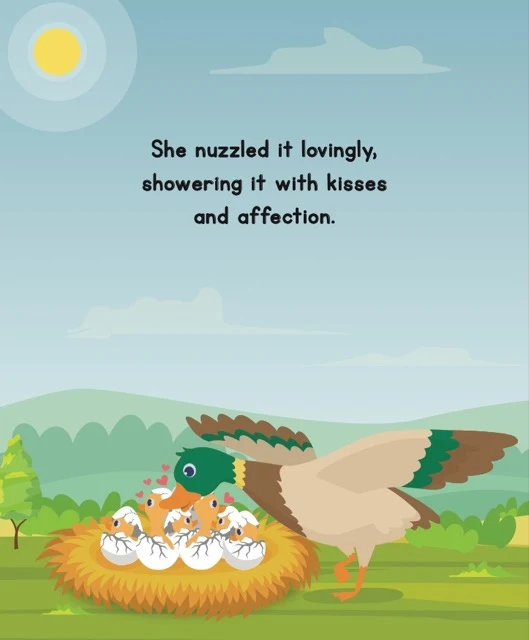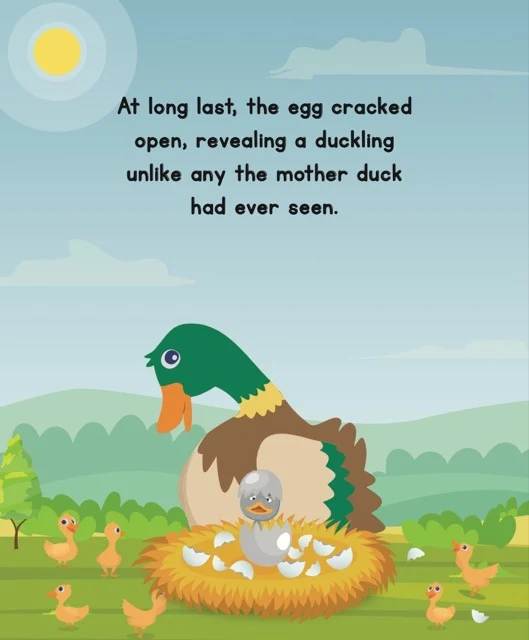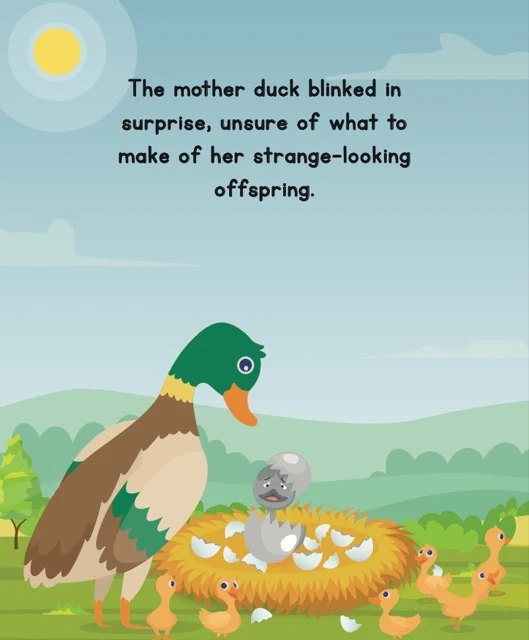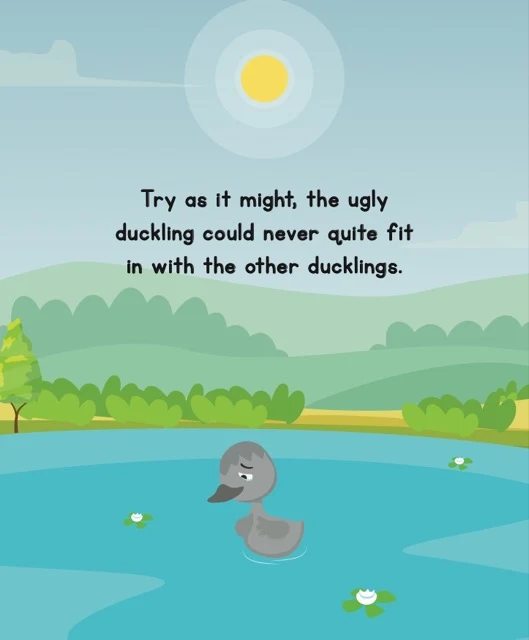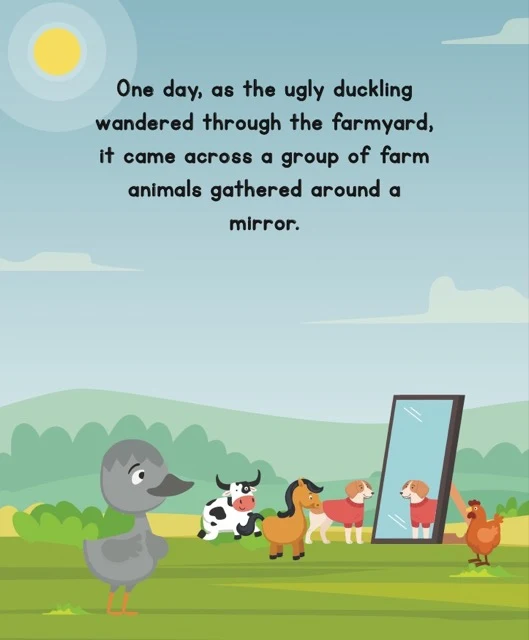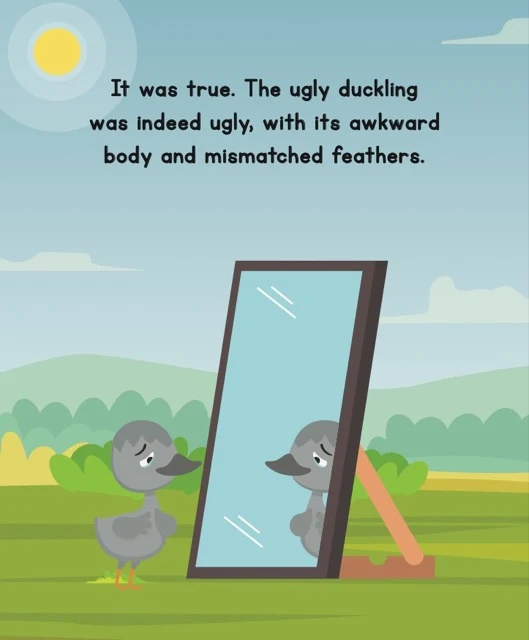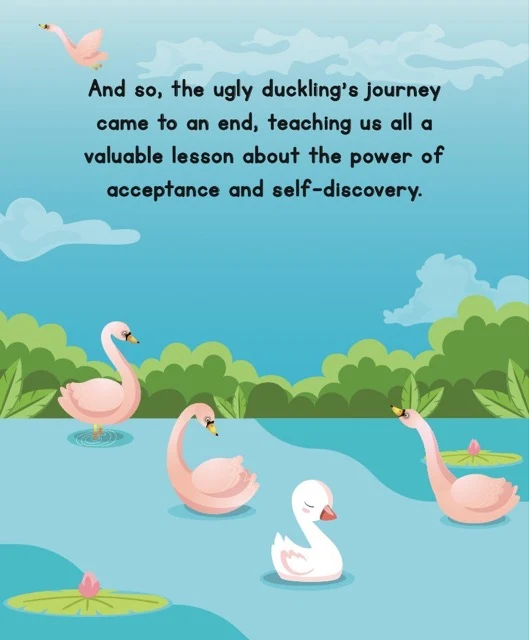The Ugly Duckling: A Thematic Analysis
This document analyzes Hans Christian Andersen's "The Ugly Duckling," exploring its central themes of inner beauty versus outward appearance, self-acceptance and belonging, and transformation and growth. It examines these themes through the lens of various sources, including a visual retelling and an academic analysis, highlighting the story's powerful message of hope and self-discovery. The analysis also discusses the story's setting, character development, and symbolism, emphasizing its contemporary relevance to issues like bullying and self-esteem. Ultimately, the document underscores the enduring power of the story's message of embracing individuality and finding one's place in the world.
The Ugly Duckling: Themes and Analysis
Briefing Document: Exploring Themes of "The Ugly Duckling"
This document reviews the main themes and important takeaways from various sources related to Hans Christian Andersen's "The Ugly Duckling." The sources include a visual retelling, a FAQ, and an academic analysis guide.
Central Themes:
●
Inner Beauty vs. Outer Appearance: The story consistently emphasizes that outward appearances can be deceptive, and true beauty lies within. The Ugly Duckling, initially mocked for his awkward looks, blossoms into a graceful swan, revealing his inherent worth. The "Understanding The Ugly Duckling" source explicitly states, "The main message of 'The Ugly Duckling' is that inner beauty and individuality are more important than outward appearances"
●
Self-Acceptance and Belonging: The Ugly Duckling’s journey highlights the universal yearning for acceptance and belonging. He is repeatedly rejected for his differences, facing isolation and despair. The "Retelling" source emphasizes this, stating, "The Ugly Duckling is different from his siblings and the other animals. He is mocked and rejected because of his appearance, which leads to feelings of loneliness and sadness." His eventual transformation and acceptance by the swans represent the triumph of self-acceptance and finding one’s true place.
●
Transformation and Growth: The story uses the metaphor of physical transformation to depict inner growth and the realization of potential. The Ugly Duckling's challenging experiences, particularly during the harsh winter, contribute to his eventual emergence as a beautiful swan. The "Understanding" source explains this as, "The Ugly Duckling's transformation symbolizes the realization of his true potential and inner beauty. It suggests that appearances can be deceiving and that inner worth may emerge over time."
Key Facts and Ideas:
●
Setting: The farmyard setting initially reinforces the Ugly Duckling's feelings of isolation and difference. The other animals' focus on conformity and their rejection of the "ugly" duckling highlight societal pressures and the impact of prejudice.
●
Character Development: The Ugly Duckling's journey is marked by resilience. Despite repeated rejection, he actively seeks acceptance and belonging, demonstrating a strong will. As the "Retelling" source notes, "He seeks acceptance in various places: with his siblings, the hens, the cat, and even wild ducks and geese." This search contributes to his self-discovery.
●
Symbolism: The swans represent beauty, grace, and acceptance – the ideals that the Ugly Duckling longs for. Their embrace of the transformed duckling symbolizes the possibility of finding belonging in a community that values true worth.
Contemporary Relevance:
The story’s themes resonate strongly with contemporary issues like bullying, social acceptance, and self-esteem. It offers a timeless message of hope and encourages individuals to embrace their unique qualities and believe in their potential, even when facing adversity. As highlighted in the "Understanding" source, "The story's ending contrasts sharply with the Ugly Duckling's initial experiences. Instead of rejection and mockery, he finds acceptance, love, and belonging among the swans."
Conclusion:
"The Ugly Duckling" is a powerful tale that transcends time. It uses simple yet profound imagery and a compelling narrative to deliver a universal message about self-acceptance, inner beauty, and the potential for transformation. The story serves as a reminder to look beyond superficial appearances and value the unique qualities that reside within each individual.
The Ugly Duckling: A Retelling
The Ugly Duckling FAQ
What is the main problem the Ugly Duckling faces?
The Ugly Duckling is different from his siblings and the other animals. He is mocked and rejected because of his appearance, which leads to feelings of loneliness and sadness.
How does the Ugly Duckling try to find acceptance?
He seeks acceptance in various places: with his siblings, the hens, the cat, and even wild ducks and geese. However, he is repeatedly rejected due to his appearance.
What happens during the harsh winter?
The Ugly Duckling struggles to survive the harsh winter alone. He almost freezes to death but is rescued by a peasant. However, he is soon scared away by the peasant's children.
Where does the Ugly Duckling go in the spring?
He finds a beautiful lake where he encounters magnificent birds he has never seen before – swans. He feels drawn to them but believes he is too ugly to join them.
What does the Ugly Duckling discover about himself?
Looking at his reflection in the water, he discovers he has transformed into a beautiful swan. His awkward, gray appearance is gone, and he is no longer the "ugly duckling."
Why is this transformation significant?
The transformation signifies the Ugly Duckling's true nature. He was always a swan, but his beauty wasn't visible at first. This symbolizes the potential for inner beauty to emerge over time.
What is the message of the Ugly Duckling story?
The story emphasizes that appearances can be deceiving. It teaches us to value inner beauty and embrace our individuality, even when it makes us different.
How does the story end?
The Ugly Duckling joins the other swans and is finally accepted for who he truly is. He experiences joy and belonging, proving that true happiness comes from embracing one's true self.
Understanding the Ugly Duckling
Understanding The Ugly Duckling
Short Answer Quiz
Instructions: Answer the following questions in 2-3 sentences each.
1.
How do the other barnyard animals treat the Ugly Duckling in the beginning of the story?
2.
What physical characteristics distinguish the Ugly Duckling from his siblings?
3.
Why does the Ugly Duckling leave the farmyard?
4.
Describe the challenges the Ugly Duckling faces during the winter.
5.
What is the Ugly Duckling's initial reaction when he sees the swans?
6.
What does the Ugly Duckling see when he looks at his reflection in the water?
7.
How do the swans react to the transformed Ugly Duckling?
8.
What does the Ugly Duckling's transformation symbolize?
9.
How does the story's ending contrast with the Ugly Duckling's experiences in the beginning?
10.
What is the main message or moral of "The Ugly Duckling"?
Answer Key
1.
The other barnyard animals treat the Ugly Duckling poorly. They mock and exclude him because of his different appearance, making him feel like an outcast.
2.
The Ugly Duckling is described as larger and more awkward than his siblings. He also has gray, fluffy feathers while his siblings have smoother, yellow feathers.
3.
The Ugly Duckling leaves the farmyard because he can no longer bear the constant teasing and rejection from the other animals. He feels unwelcome and hopes to find a place where he is accepted.
4.
During the winter, the Ugly Duckling faces loneliness, hunger, and extreme cold. He nearly freezes to death and struggles to survive on his own.
5.
When the Ugly Duckling first sees the swans, he is awestruck by their beauty and grace. He feels an immediate connection but also believes he is too ugly to be among them.
6.
Looking at his reflection, the Ugly Duckling discovers he has transformed into a beautiful swan. His awkward gray feathers are gone, replaced by elegant white plumage.
7.
The swans welcome the transformed Ugly Duckling warmly and accept him as one of their own. They do not judge him based on his past appearance.
8.
The Ugly Duckling's transformation symbolizes the realization of his true potential and inner beauty. It suggests that appearances can be deceiving and that inner worth may emerge over time.
9.
The story's ending contrasts sharply with the Ugly Duckling's initial experiences. Instead of rejection and mockery, he finds acceptance, love, and belonging among the swans.
10.
The main message of "The Ugly Duckling" is that inner beauty and individuality are more important than outward appearances. It encourages us to embrace our differences and believe in ourselves even when others do not.
Essay Questions
1.
Analyze how the setting of the farmyard contributes to the Ugly Duckling's feelings of isolation and difference.
2.
Explore the various ways the Ugly Duckling seeks acceptance and belonging throughout the story. How do these attempts shape his understanding of himself?
3.
Discuss the significance of the winter season in the Ugly Duckling's journey. How do his challenges during this time contribute to his eventual transformation?
4.
Examine the role of the swans in the story. How do they represent the ideals that the Ugly Duckling longs for?
5.
Connect the themes of "The Ugly Duckling" to contemporary issues of social acceptance and self-esteem. How does the story remain relevant today?
Glossary of Key Terms
●
Protagonist: The main character of a story. In "The Ugly Duckling," the protagonist is the Ugly Duckling.
●
Antagonist: The character or force that opposes the protagonist. In "The Ugly Duckling," the antagonists could be considered the other barnyard animals who mistreat the protagonist.
●
Theme: The underlying message or idea explored in a literary work. The themes of "The Ugly Duckling" include inner beauty, self-acceptance, and the importance of individuality.
●
Symbolism: The use of objects, characters, or events to represent abstract ideas. The Ugly Duckling's transformation into a swan is a symbol of his true potential and inner beauty coming to light.
●
Transformation: A significant change in form, appearance, or character. The Ugly Duckling undergoes a physical transformation into a swan, but the story also highlights his internal growth and self-discovery.
●
Self-acceptance: Embracing and valuing oneself, including one's strengths and weaknesses. The Ugly Duckling learns to accept himself for who he truly is, despite the initial rejection he faces.
●
Inner beauty: The qualities that make a person valuable and admirable, such as kindness, compassion, and strength of character. "The Ugly Duckling" emphasizes that inner beauty is more important than outward appearance.
●
Belonging: The feeling of being accepted and valued as a member of a group. The Ugly Duckling's journey highlights his longing for belonging and his eventual finding it among the swans.
●
Moral: The lesson or message conveyed by a story. The moral of "The Ugly Duckling" is that it is important to be kind to others and to value people for their inner qualities rather than their outward appearance.
●
Fairy Tale: A genre of children's literature that typically features magical elements, fantastical creatures, and a clear moral message. "The Ugly Duckling" is a classic fairy tale.










